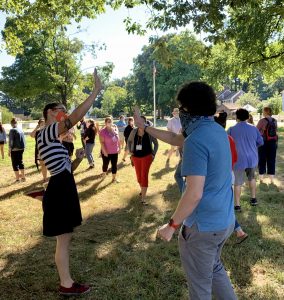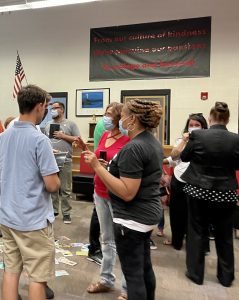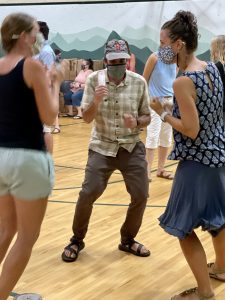Sep 02, 2021 “Air Handshake Mingle” and “Distanced Concentric Circles” – Active Engagement and Social Connection at a Physical Distance
Rather than opening a program or class with a whole circle introduction I always begin rapport building and reflective dialogue with partner or small group sharing activities and blend in simple, non-threatening — but relevant, context setting– questions or an object/picture/quote to use as a talking point. This allows participants an opportunity to warm up by interacting with just one or two others at a time before sharing with the larger group. This incremental building of connections one or two people at time rather than beginning as a whole classroom or whole group “sharing circle” helps learners build comfort with each other and the group process, and honors the introverts, leading to more engagement, buy-in, and in-depth reflection discussions later on.
Air Handshake Mingle and No Touch Greetings
 Handshake Mingle blended with reflection and rapport building questions has main staple of my community building and academic/training engagement repertoire for many years. It is a favorite because there is choice involved, and no one person is in the spotlight. It also works as an active processing/reflection/review activity to start group dialogue on a specific experience or academic/training topic. This tried-and-true method is social and incrementally sequenced and useful for building rapport, making introductions, creating connections, reviewing names, and becoming more comfortable with each other. This activity can be used a number of times throughout a group’s experience to reflect and review and create context around a subject. Over the years I have become very intentional about the way I carefully sequence it and weave in choice and control and awareness of the needs of introverts in my groups. Amidst the COVID crisis I create spaces that allow for physical distance, adhere to masking protocols, and adapt it to include “air greetings” or no-touch greetings inspired by this article from CNN on “No Touch Greetings from Around the World .
Handshake Mingle blended with reflection and rapport building questions has main staple of my community building and academic/training engagement repertoire for many years. It is a favorite because there is choice involved, and no one person is in the spotlight. It also works as an active processing/reflection/review activity to start group dialogue on a specific experience or academic/training topic. This tried-and-true method is social and incrementally sequenced and useful for building rapport, making introductions, creating connections, reviewing names, and becoming more comfortable with each other. This activity can be used a number of times throughout a group’s experience to reflect and review and create context around a subject. Over the years I have become very intentional about the way I carefully sequence it and weave in choice and control and awareness of the needs of introverts in my groups. Amidst the COVID crisis I create spaces that allow for physical distance, adhere to masking protocols, and adapt it to include “air greetings” or no-touch greetings inspired by this article from CNN on “No Touch Greetings from Around the World .
Materials: None needed, but entry-task objects/images and quotes can be woven into this activity. I also like to create the first partnering using an object-based connection such as dominoes, playing cards, match game cards (see post). I always make this deeper introductory activity or a kinesthetic reflection or review by mix get-to-know-you or reflective questions into the exercise, so having these reflection or review prompts prepared in advance can be helpful.
Facilitation Note: Facilitators use a variety of greetings in this activity—some of them can get pretty silly. I tend to start simply, using familiar or simple no-touch greetings (especially now). I purposely facilitate a “slow” connection focused version of this activity, having people revisit previous partners, so they build connections with at least four or five people in the room (a very different activity than the “quickly visit everyone” version). During the COVID era I tend to facilitate this activity with smaller groups outside if possible, or inside following masking and physical distancing protocols which I have found still allow the group to engage playfully and meaningfully. The “Air High Five”, “Air Low Five”, “Hand over Heart”, “Bow”, “Namaste”, “Air Fist Bump” and “Make it Up as You Go Along” touchless greetings are my new favorites.
Facilitation Suggestions:
• First, have everyone find a partner (using their dominoes or match game cards) following appropriate local physical distancing protocols and give each other an Air High 5. Have participants recognize this person as their “Air High 5” partner. To increase buy-in and facilitate a smooth transition from one activity to another, this first partner could be the domino or playing card partner from the pre-group or entry task pairing.
 • Next, ask participants to find a new partner, and give each other an Air low 5. This is their “Air Low 5” partner. I usually give these partners a reflective or get-to-know-you question, a context-setting/topical question, or ask them to share about their entry activity choice. When I use Air High Fives or Air fist bump fireworks, since these are often celebratory gestures, I often connect the reflection conversation with “celebrations.” I ask partners to share something worth celebrating and frame this around their reason for being in the group. For a group of educators, it could be “something worth celebrating about this school year: a personal achievement, a success story with a student, a new initiative at your school.”
• Next, ask participants to find a new partner, and give each other an Air low 5. This is their “Air Low 5” partner. I usually give these partners a reflective or get-to-know-you question, a context-setting/topical question, or ask them to share about their entry activity choice. When I use Air High Fives or Air fist bump fireworks, since these are often celebratory gestures, I often connect the reflection conversation with “celebrations.” I ask partners to share something worth celebrating and frame this around their reason for being in the group. For a group of educators, it could be “something worth celebrating about this school year: a personal achievement, a success story with a student, a new initiative at your school.”
• After a few moments of partner conversation, have participants revisit their Air High 5 partner, then their Air Low 5 partners, moving amongst the group to find those original partners.
• I then introduce the information from the CNN article about no touch greetings from around the world and invite them to find a “Hand Over Heart” partner. I often blend a reflection question with this partner about emotional connection or “where their heart is.”
• Continue this sequence, adding on new partners/activities as appropriate. You will witness laughter, positive interaction, and fun; and participants will remember their partners and conversations. *The revisitation to each partner is in my view the power of this activity – leader to a deeper and more authentic connection with a few members of the group that can be built upon and extended to the larger group over time.
• Invite participants to help you come up with new touchless handshakes or present their own; this enhances ownership and involvement. I often frame this as a “Make it Up as You Go Along” partner and weave in a conversation about the creative adaptations that are a necessary part of the daily work as a teacher and student. I invite them to reflect on what it feels like to adapt under pressure and create something new and positive along the way.
• Use this technique as a closing at the end of a class or program: Ask participants to go back through their handshake sequence and revisit their partners to reflect on their thoughts regarding the program/lesson. Invite the “celebration” partners share something from the program that was worth celebrating or a high point for them. • This can be used multiple times with a group to reflect on specific questions/academic content.
 Facilitation Tips: Be thoughtful and observant and use handshakes that are appropriate, taking into consideration space, physical abilities, setting, cultural norms, and the background of your group. One of my favorite handshake is “fishing” partners (one is the fisher with reel/rod and the other the fish). BUT, I am very careful about when to introduce sillier handshakes, if at all.
Facilitation Tips: Be thoughtful and observant and use handshakes that are appropriate, taking into consideration space, physical abilities, setting, cultural norms, and the background of your group. One of my favorite handshake is “fishing” partners (one is the fisher with reel/rod and the other the fish). BUT, I am very careful about when to introduce sillier handshakes, if at all.
Resource: I learned this as a community building activity years ago from my colleague Aimee Desrosier Cochran. It has been written up many different ways in this blog and both editions of Tips & Tools for the Art of Experiential Group Facilitation 2007, 2016. An academic review and reflection variation is described in the Inspired Educator, Inspired Learner book.
Distanced Concentric Circles
A more reserved, but active partner sharing technique for community building, review and reflection is Concentric Circles. This kinesthetic activity can be used as an icebreaker, a discussion starter, an active reflective approach, or a closing activity. It’s an effective method to break up direct instruction in a training or teaching situation and get participants away from their desks to review academic material or topics for discussion. Each person is only asked to converse or share with one other person at a time, and everyone has the opportunity to participate. This activity can be adapted to most age or size groups. It works especially well with larger groups. With COVID era protocols in mind, I facilitate this outside if possible, and following distancing and masking protocols. Indoors I facilitate this in smaller groups and often use spot markers to delineate the physically distanced spacing of the inside and outside circle. If spacing is an issue this can be done in two shifting parallel lines.
Concentric Circles Facilitation Suggestions:
• Divide the group in half, forming two physically distanced circles with the participants facing each other in an inner circle and an outer circle.
• Ask participants to greet the person they are facing and converse about an academic topic, a get-to-know-you question, reflective prompt, or why they chose the object they did during the hook activity.
• You might have the inside circle take on one viewpoint and the outside circle the other. Or have participants from one department on the inside and another on the outside to facilitate communication between different groups/differing viewpoints. I’ve used this in the classroom to explore character with the inside circle taking on one characters viewpoint and the outside another, as they discuss questions. This could be done for current events to discuss two perspectives on an issue.
• For academics, the inside circle could “quiz” the outside circle as a formative assessment and review. Or, the inside circle could run a rough draft of their writing, or project by the outside circle for feedback or input. See Inspired Educator for a complete descriptor of using this with prepared index cards and tallying for feedback and assessment.
• After a few moments, or when the conversational energy diminishes, have one of the circles rotate a few places: “Inside circle move three people to your right.” Participants form new partnerships, greeting those they bypass along the way.
• Invite the new partners to greet each other, and provide another topic to discuss and/or cooperative activity.
• Continue the activity; alternating movement between the inside and outside circle, followed by review/reflection questions and/or partner activities.
Facilitation Tips: I use this activity interchangeably with handshake mingle. It is helpful when I am in a more structured setting or facilitating conversation around a serious topic. Both activities can be used multiple times throughout a program or school year—for building relationships and rapport at the beginning and for reflection and review later on (see Inspired Educator Inspired Learner for more academic variations). The option of placing different departments of an organization or people of differing viewpoints in the different circles is a way to ensure intra-group conversations occur. I’ve used it for data gathering and formative assessment with the inside circle interviewing, collecting, recording information, insights, opinions from the outside circle and vice versa.
Resource: I was first introduced to this activity as an icebreaker facilitated during my time in experiential education grad school in 2000 with my colleague Hutch Hutchinson. I’ve re-purposed it over the past 25 years as a reflection activity originally inspired by Luckner and Nadler’s Processing the Experience (1997). Versions are written up in Inspired Educator, Inspired Learner and Tips & Tools for the Art of Experiential Group Facilitation.
References:
Andrew, Scottie (2021) CNN Travel Online: Stop Shaking Hands, Do This Instead: Article Link
Stanchfield, Jennifer (2014). Inspired Educator, Inspired Learner: Experiential, Brain-Based Activities and Strategies to Engage, Motivate, Build Community and Create Lasting Lessons. Bethany, Ok: Wood N Barnes Publishing
Stanchfield, Jennifer(2016) Tips & Tools for the Art of Experiential Group Facilitation. Second Edition. Bethany, Ok: Wood N Barnes Publishing
Willis, J. (2014) “Brain-based teaching at The Learning & the Brain Conference: Engaging 21st Century Minds. Boston, MA.



No Comments